Who Is The Author That Wrote Over 100 Childrens Books About Animals
Teaching kids animals is akin to colors and numbers when they're little. Right? We love when children can identify dogs, cats, cows, and chickens. Even ameliorate when they tin make the animal racket, right?
As children grow, their interest in animals expands. Now they can learn more facts and details about animals from around the world with children'south flick and nonfiction books.
Below, you lot'll detect so many fantabulous reading choices all about animals for immature readers and up to independent readers. In other words, ages 0 – fourteen.
If y'all desire more specific categories and non full general books about animals, await through these lists:
Amphibians & Reptiles: Amphibians & Reptiles
Birds: Beautiful Bird Books for Kids
Bugs: Best Children's Books about Bugs (Insects, Worms, and Arachnids)
Cats: Picture Books About Cats
Dinosaurs: Outstanding Dinosaur Books for Kids
Dogs: Picture Books About Dogs
Narwhal: Best Narwhal Books for Kids
Nocturnal Animals: 12 Books About Nocturnal Animals
Ocean Animals: 29 Books for Kids About Ocean Animals
Pets: Picture Books About Pets
Sharks: Shark Week Books for Kids
Wonderful Children'due south Books About Animals
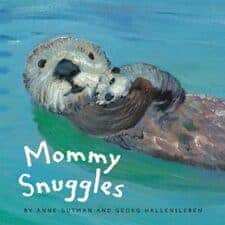

Mommy Snuggles by Anne Gutman and Georg Hallensleben
(ages 0 – 3)
Creature mothers take good care of their babies. "Mommy swan glides with her cygnet / under her wing." See the animals and learn the names of the adults and babies.
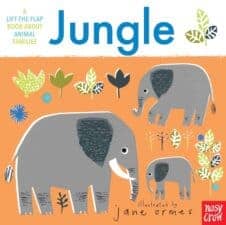
Jungle illustrated by Jane Ormes
(ages 0 – 3)
What an adorable book to acquire about animate being families! I beloved the color schemes with neon orange, blues, and greens. For each animal, you lot'll read what the daddy is called, the mommy is chosen, and and so lift-the-flap under the mommy to read what the babies are called. "A daddy peafowl is chosen a peacock. A mommy peafowl is called a peahen. Baby peafowl are called peachicks." Also in this serial and the same format only ready on a farm is the new Noisy Crow board book called Subcontract .
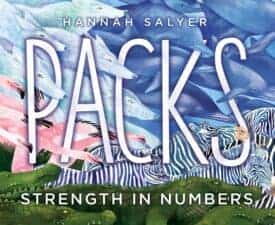
Packs by Hannah Salyer
Beginning with minimal text, these gorgeous, captivating illustrations show groups of animals–herds, pods, packs– animals together. As yous're invited into the book, the author presents more interesting text written from the collective we like this, "We frogs can get one noisy army…Together, nosotros sing!"
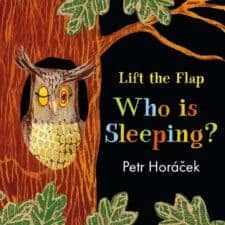
Who Is Sleeping? A Lift-the-Flap Book by Petr Horacek
(ages 0 – 3)
Introduce your babies and toddlers to sleeping animals like a bear, a frog, and a fish in their habitats similar a river or a tree in this interactive board book.
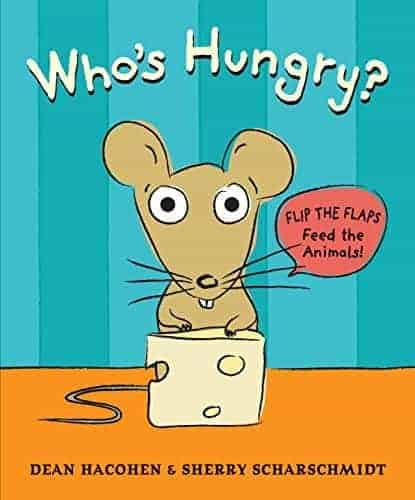
Who'due south Hungry Flip the Flaps Feed the Animals by Dean Hacohen and Sherry Scharschmidt
(ages 0 – 3)
Help feed the animals. On each two page spread, lift the flap to come across what information technology is that beast wants to eat. This is a keen volume for toddlers who are just learning about animals and practicing their fine motor skills. The illustrations are assuming and elementary, as is the text. Very well done!
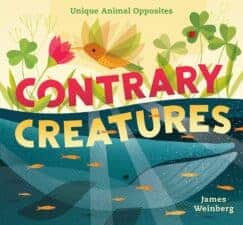
Opposite Creatures past James Weinberg
(ages two – iv)
What a lovely introduction to animals with unproblematic descriptions and unique illustrations! "Some move very slowly . . . simply some are fast." You lot'll find yourself with plenty to discuss. Plus, you'll enjoy the variety of creatures and the unique dotty illustrations.
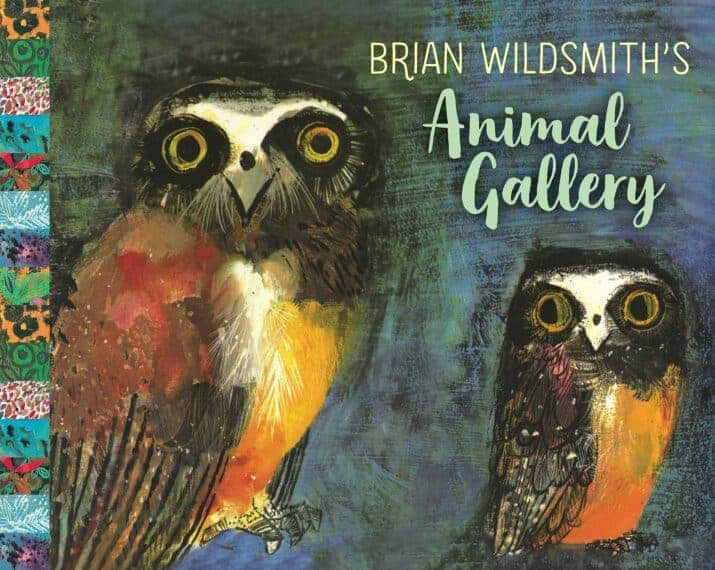
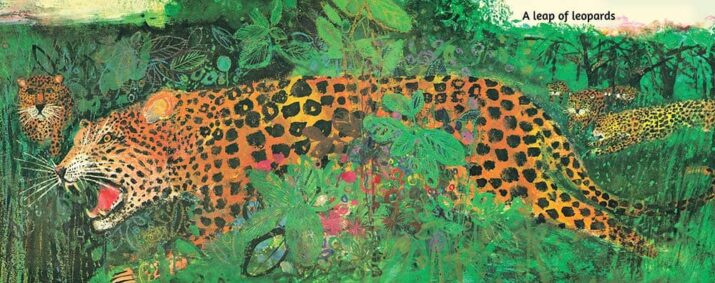
Animal Gallery by Brian Wildsmith
Although there are many books about the nouns for collectives of animals, this book stands out for its lush illustrations. A bloat of hippopotamuses shows big, expressive hippos. Colorful parents on green and dark brown backgrounds depict a pandemonium of parrots. You'll also find a stare of owls, a prickle of hedgehogs, and a hover of trout, just to proper noun a few.
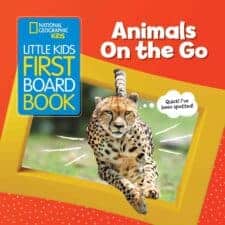
Animals on the Get (National Geographic Kids)
(ages two – 5)
Full-color photos show young readers moving — slithering, hopping, sliding. I similar the simple text plus bonus circle insets of info and goofy thought bubbles.

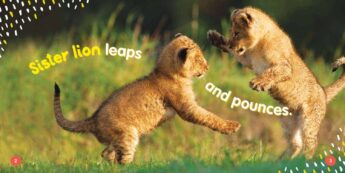
Blood brother, Sister, Me and You by Mary Quattlebaum
(ages 2 – half dozen)
Celebrate the sibling bond among animals with gorgeous photographs that match the animal's actions. "Guppies flash with finny flicks." In my feel, children prefer photographs to illustrations of animals and so I know this volume volition be a lovely read-aloud choice for your immature readers.
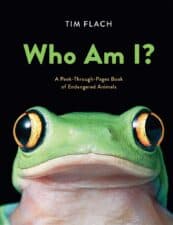
Who Am I? A Peek-Through-Pages Volume of Endangered Animals past Tim Flach
(ages 4 – 8)
What a care for! Hither'due south another approximate-who-I-am picture volume filled with gorgeous, total-color photographs of endangered animals. The author shows readers a peek-through glimpse of an fauna forth with a written clarification. Can y'all judge who this brute is fifty-fifty without the photograph? "I have a suit of armor and a super-long tongue for slurping up insects–yum!" Turn the page to meet the answer– a pangolin! (I guessed incorrectly, how did you lot do?)

Whose Track Is That? past Stan Tekiela
Clues paired with a photo of creature tracks prompt readers to guess the animal who makes the rail and fits the clues. Turn the page to find the answer and learn information about each North American creature like the bobcat, raccoon, and robin. Easy to read with colorful photographs, this is an appealing choice for preschool and elementary age kids.
Oversized, dramatic white on black pictures of animal bones take hold of your attention. Use the picture and clues to guess what animal information technology is. Turn the page to see the colorful picture, the reply, and more data. This fascinating book volition go kids jazzed well-nigh both bones and cool animals.

The Alphabet of Peculiar Creatures past Katie Abey
(ages 8 – 12)
Kids who like wacky and weird will adore this volume of unusual creatures starting with A for Axolotol and continuing to J for Jerboa and Z for Zebu. Each folio shows an illustration of the fauna plus the pronunciation and a judgement or ii of information about the animal. I'm loving this book! "Q is for QUOKKA (KWAH-KA) Quokkas are small, furry creatures related to kangaroos. They are about the aforementioned size as a cat, and always expect similar they are smiling."
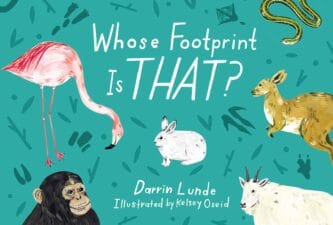
Whose Footprint Is That? by Darrin Lunde, illustrated by Kelsey Oseid
(ages half-dozen – 9)
In that location'southward a lot to dear about this book. The repeating question "Whose footprint is that?" gives kids a shell, a sense of what to expect. On the folio of questions, readers volition notice an illustrated inkling (part of the animal) equally well as read a written inkling, "These are two footprints. They were made by hopping." This picture and factual support are supportive immature readers as they brand deductions based on the clues. The entire experience of this book, the art as well as the content, makes nature exciting and highly-seasoned to young readers. Highly recommended.

Search and Spot Animals! past Laura Ljungkvist
(ages four – 8)
Ljungkvist's motion picture book illustrations are simple, make clean, and not besides crowded. For example, on a bright yellowish groundwork, look at the royal and blue chickens to discover a dozen eggs. Lovely.
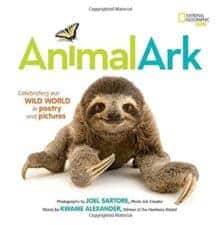
Animate being Ark Celebrating Our Wild Earth in Poetry and Pictures by Kwame Alexander, photos by Joel Sartore
(ages eight – 12)
Alexander writes about each animal or animal grouping in evocative haikus with jaw-dropping photographs taken by Joel Sartore. For a dramatically angled fruit bat on a black background, Alexnder writes "wings like a cape / ready for flying / into the sweet, dark nighttime".
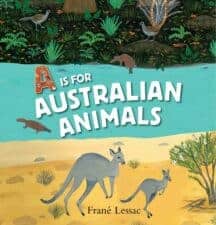
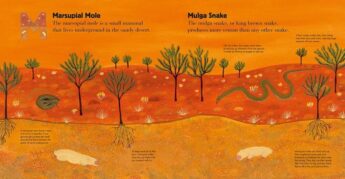
A is for Australian Animals by Frane Lessac
(ages 8 – 12)
Gorgeous artwork showcases the animals of Commonwealth of australia with digestible tidbits of information nigh each 1. Australia has some of the most interesting wildlife I retrieve — emus and numbats, platypus and yabby. You'll learn a lot from this picture volume. Add together this to your classroom library, your kids will thank you lot.
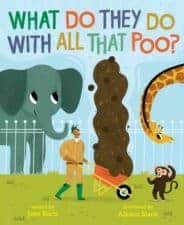
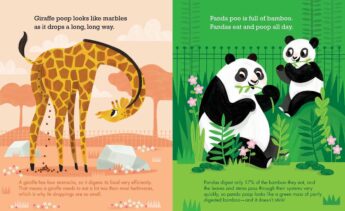
What Do They Do With All That Poo?
(ages 8 – 12)
In that location'due south potty humor and and then there are books like this — literally nearly poop. Depending on your tolerance for grossness, this book will probably fascinate you and your kids. We love information technology! Learn nearly the poop of unlike zoo animals — pandas, hippos, elephants, hyenas, bats, and more. You lot'll read what'south in each animal's poo, the shape and color, and other pertinent facts. If you've ever been curious almost fauna poop, quell your curiosity with this informative movie volume.
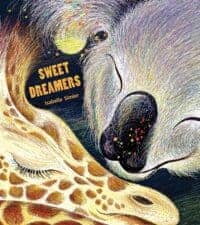
Sweet Dreamers past Isabelle Simler
(ages viii – 12)
Each evocative poem captures an animal sleeping and dreaming, giving the states imagery that transports us to those sleepy moments. "The hedgehog dreams safely in his shelter. Under a pile of leaves, his spiky coat, he's rolled up, wrapped upwardly for a long remainder." The illustrations have so much movement — neon, black, white, red, and green with lots of lines. Information technology's fascinating to see the humpback whale sleeping underwater "the humpback whale dreams vertically with plankton at every level."
Interesting information well-nigh adaptations like tall ears, spines, camouflage, and long sticky tongues plus gorgeous full-colored photos (that I could look at all day long) and brightly colored pages make this a nonfiction book kids are sure to pour over for hours.
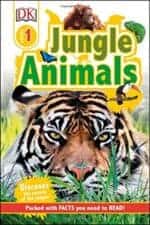
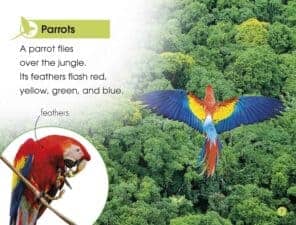
DK Level i Jungle Animals by Camilla Gersh
(ages 5 – 8)
In a give-and-take, perfect. This little book packs a big punch with the perfect balance of colorful visuals (photographs) and leveled, informational text. Fantastic!
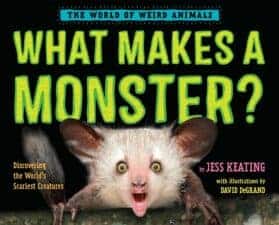
What Makes a Monster? Discovering the World's Scariest Creatures by Jess Keating, illustrations by David DeGrand
(ages half-dozen – 12)
Keating writes in a way that gives kids lots of data in a readable, engaging way. I honey the design, as well –it'southward a mix of photographs, illustrations, cool fonts, and brilliant colors. What Makes a Monster is a must-read filled with unexpected information about fascinating, dangerous animals.
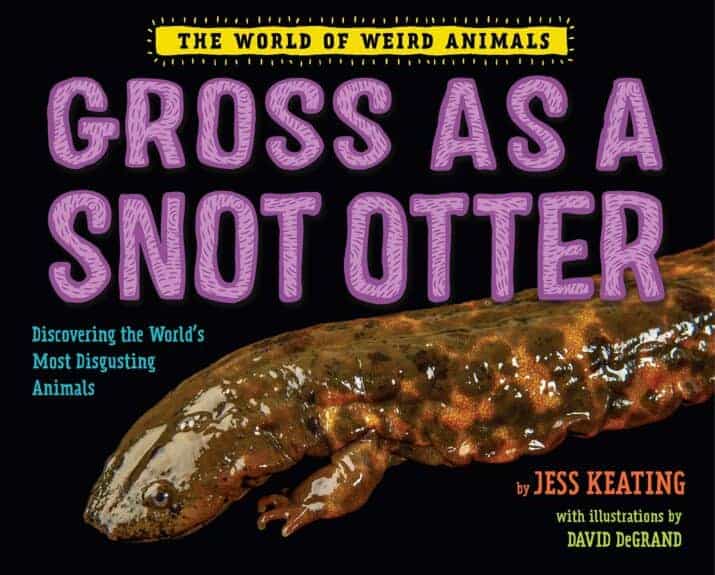
Gross Every bit A Snot Otter: The World of Weird Animals past Jess Keating, illustrated by David DeGrand
(ages 6 – 12)
Keating'southward brilliant series of weird animals continues with a book featuring the grossest animals on the planet. Colorful and highly-seasoned layouts plus photographs and illustrations add together so much pizazz that yous can't help but read this book cover to cover. Well-written, engaging information almost the snot otter, a salamander covered in mucus, a zombie worm who lives in a whale carcass and eats bones, and many more animals will soon make yous an expert on these gross animals, likewise.
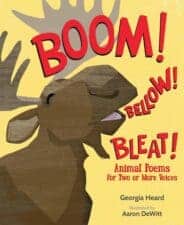
Boom! Bellow! Squeal! Brute Poems for Two or More Voices by Georgia Heard, illustrated by Aaron DeWitt
This poetry book will help kids understand the dazzler of words, oral reading, and imagery simply they'll also come across the playfulness in poetry and observe new animal sounds they've never known. The poems are written in several colors. Children volition cull the color of text to read (black or crimson, for case) starting with the poem "Animal Songs." One reader reads the brute name written in black text. The other reads that animal'due south sound written in red text. ("Kangaroos / Chortle") The book is filled with the noise of fish, geese, frogs, mockingbirds, snakes, bees, and many more animals.
"Songsters of the Sea"
I dive
downwardly deep
in a sapphire sea.
Suspended.
I sing.
an aria.
WOOOOOOOO
WOOOOOOOO
My watery hymn
serenades humpback whales
thousands of miles away.
Like an echo.
I hear a whale sing.
my song dorsum to me.
…
(This is an excerpt, not the full poem.)
This is a MUST-Own volume for teachers and school libraries, homeschoolers, and poesy-loving parents. It captures the most interesting sounds of nature. Kids will clamor to read these with parents, teachers, friends, and classmates.
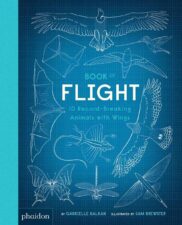
Book of Flight: ten Record-Breaking Animals with Wings by Gabrielle Balkan, illustrated past Sam Brewster
(ages vi – 12)
This absurd, oversized flick book gives readers clues about unique flying creatures then asks readers to judge the bird using the clues and the illustration. For instance, when trying to guess the fastest flyer, you'll read that the bird migrates to Asia, swallows flying ants and bees for breakfast, and was named for the needle-like tips of its tail feathers. Turn the page to observe the answer… a white-throated needletail. Even cooler, the answer has a full-color, textured illustration plus more information. The animals in this book include an emperor dragonfly, a Philippine hawkeye, a Madagascan flying fox, and a California flying fish.
I love the entertaining stories and the artwork as well as the text to picture ratio which is absolutely perfect! Perfect for reading aloud and perfect for reading to yourself. The stories are about all animals, some from unlike cultural traditions; virtually of the stories comprise a valuable lesson like "The Trick and the Crow" or explain a natural phenomenon like "How the Conduct Lost His Tail".
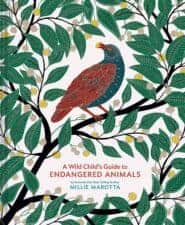
A Wild Child's Guide to Endangered Animals by Millie Marotta
(ages 8 – 12)
Whatsoever child who loves the natural globe, especially the animals, will be obsessed with this oversized book. Richly illustrated in earthy tones, the writer shares data about 43 endangered animals from the oceans to the forests, mountaintops to the tundra; all who demand protection. You may be every bit surprised at some of the animals in danger including caribou and giraffes. Plus, I suspect that you lot'll larn well-nigh a menagerie of new species you didn't know about before equally you cascade over the pages.
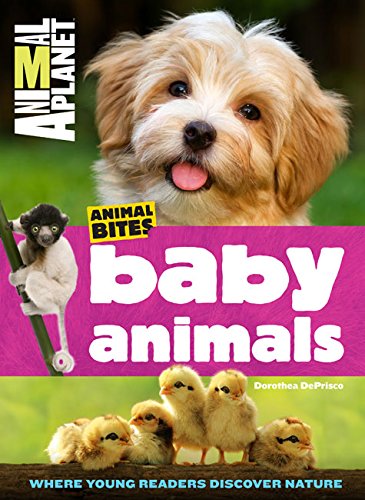
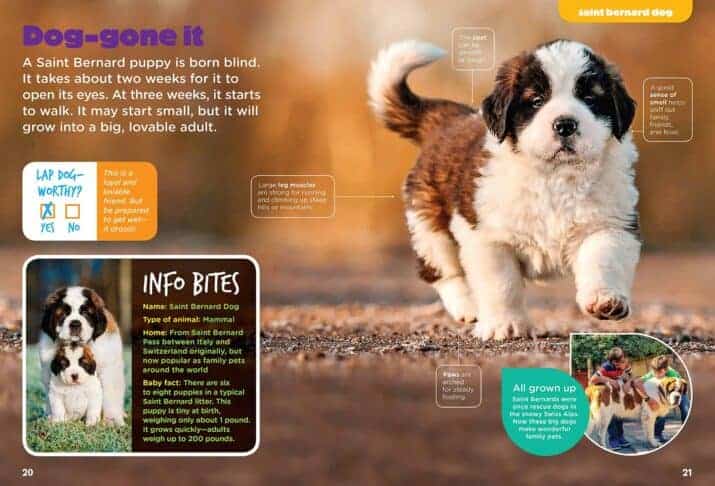
Baby Animals (Animal Planet) by Dorothea DePrisco
(ages 7+)
Gorgeous photos and interesting facts brand this one of those books yous can easily flip through to find the photos and interesting facts about young animals that you want to read. Plus, the cuteness cistron is off the charts!
Get schooled with this fascinating book about animals. It focuses on the how and why these animals move as well as cool facts. For example, did you know the gnu moves in a zigzag pattern when in danger and kicks up a dust storm when information technology spars? Ultimately, this is dandy for reluctant and struggling readers too as all kids who would love reading bite-sized facts near animals.
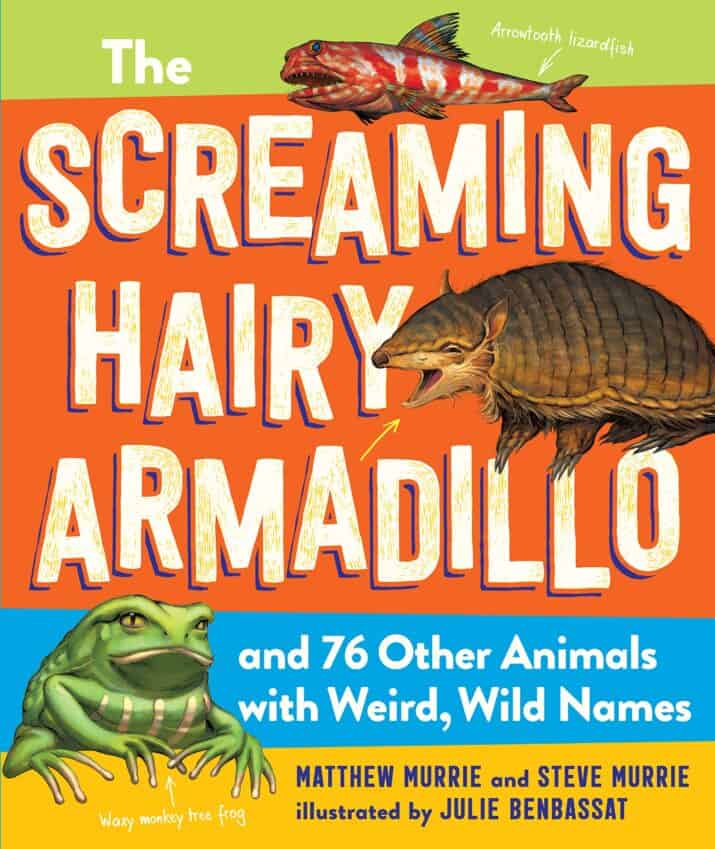
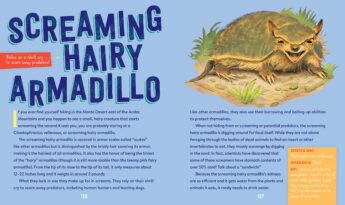
The Screaming Hairy Armadillo and 76 Other Animals with Weird, Wild Names past Matthew Murie and Steve Murrie, illustrated by Julie Benbassat
Get ready for funny names, magical names, fierce names, succulent names, and weird names. Simply even better is the ANIMALS with these unusual names. Like the striped pyjama squid which is a absurd-looking stripped squid. Or the yeti crab which is a crustacean with hairy arms. My favorite weird creature is the Tasseled Wobbegong! Permanent facts (species, habitat, and interesting details) are written in a text box with a well-written elaboration of about a page describing the animal's looks, beliefs, habitat, abilities, and more. Each animal has at least one analogy, sometimes more than than i, and sometimes a photograph. Fantastic!

Animal Planet Animals A Visual Encyclopediaby Animal Planet
(ages viii – 12)
Beautiful photographs and seize with teeth-sized chunks of information showcase more 2,500 animals from the seven major animate being groups: mammals, birds, reptiles, amphibians, insects and arachnids, invertebrates, and fish.
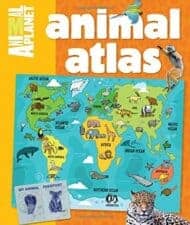
Fauna Planet Animal Atlas
(ages 6 – 12)
Extra-large pages of continents show the biomes and animals who live in each. Subsequent pages feature colorful close-up photographs of animals matched with data nigh the animate being– where it lives, why it lives there, and what information technology eats. This atlas is SO colorful and well designed, any reader volition be drawn to wait at the photographs and read it extensively. Impressive!
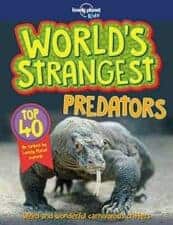
The World'south Strangest Predators Summit 40 Weird and Wonderful Carnivorous Critters
(ages 8 – 12)
Exercise you know about the weirdest predators? You might be surprised to learn that #40 on the list is the short-tailed shrew — a tiny terror with venom glands who is a predator to frogs and mice. Learn more about weird predators in this unique book that includes the Tasmanian devil, tentacled snake (and so gross), pirate spider, and #one — the love annoy! And to call back, I thought honey badgers only ate honey. It does but information technology also will swallow annihilation! Yikes.
I can see homeschoolers LOVING this nature book. Why? Because it is almost an interactive curriculum that contains both fascinating information as well as fun activities to do. For example, read nearly the bowerbird's different types of nests, then make your favorite type of nest. I love the activity thought to camouflage yourself with clothes or face painting like a leopard after reading all most leopards. Other animals include raven, skunk, deer, octopus, bat, wolf, and honeybee. Colorful illustrations throughout.
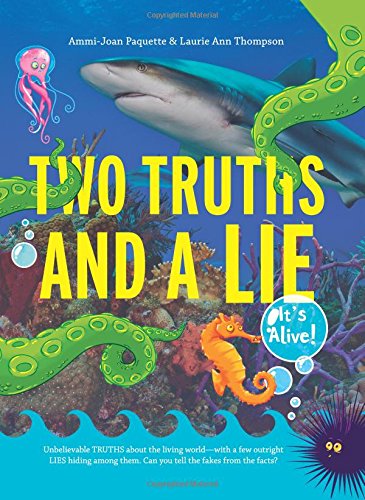
2 Truths and a Prevarication by Ammi-Joan Paquette and Laurie Ann Thompson, illustrated by Lisa Thou. Weber
(ages viii – 12)
This volume is GENIUS! It's an impressive dare really for kids to read and figure out what is true and what is a lie. Who can resist their dare? The premise promises to cement cognition of existent and false because no answers are given. Readers will exist reading, thinking deeply and researching while they're immersed in the book… The conversational tone in which this book makes the reading flow smoothly. That, plus the improver of many illustrations and photographs make this ane hard-to-put-downwardly nonfiction centre grade book.

You Might Also Like:
Books for Tweens Who Love Animals
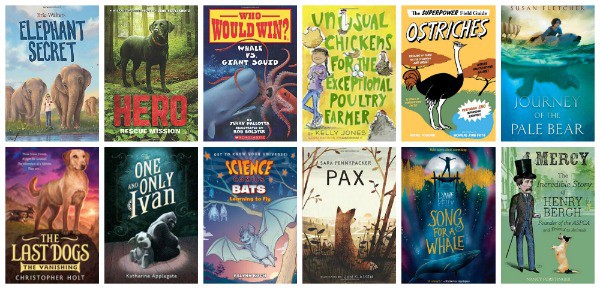
Source: https://imaginationsoup.net/childrens-books-about-animals/
Posted by: carmonaoffirest1957.blogspot.com

0 Response to "Who Is The Author That Wrote Over 100 Childrens Books About Animals"
Post a Comment